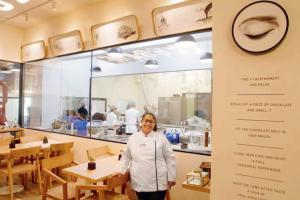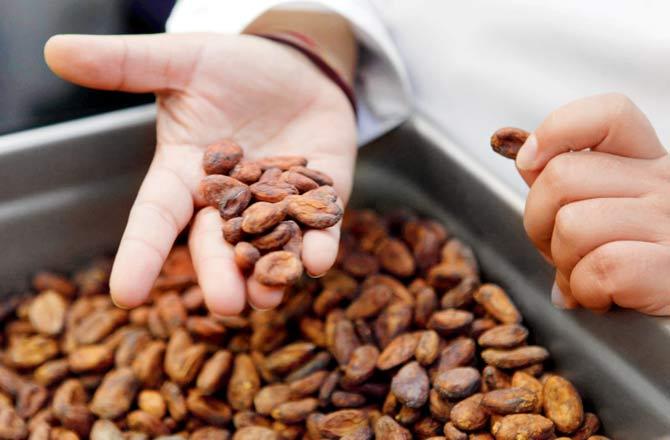First look: Chocolatier Sanjana Patel follows the journey of cacao from pod to bean to create a factory-cum-cafe-cum-school through which you can walk, learn and taste

Two years ago, Sanjana Patel, the chef behind Kala Ghoda chocolate store La Folie and its namesake cafe in Bandra, broke her right leg on a surfing holiday. It was a sign, she felt, to step back and regroup. "I couldn't stop at patisseries and boulangerie cafes. My background is chocolate. It was time to focus on the craft of serious chocolate making," says Patel, who is on the brink of throwing open the doors of Mumbai's first bean to bar chocolate factory. At the Factory Café in Mahalaxmi, she launched last month The Classroom, a cooking studio that will host pop-ups, classes and collaborations.
ADVERTISEMENT
On a first-look tour of the factory, we crane our necks to see the light installation above us. A white wall carries three sculptures of the Theobroma cacao flower, Criola cacao pod and the sweet baba white pulp that holds the beans. Wood and cane chairs surround a few tables, but the main action lies on the other side of a giant glass wall. This space is the result of Patel's travels in a wheel chair, with husband Parthesh, across community farming spaces in Guatemala, Ecuador and the Amazon.
"In Lachuá, Gautemala, I came across the oldest Mayan cacao farms where they work with heirloom cacao beans of criollo and trinitario variety. They follow organic practices and make their own chocolate by stone grinding the beans. They add a little sugar and press it down like a cake." In Belize, Central America, she met an investment banker from New York who has set up a genetics labs and grafts heirloom cacao beans for the past 12 years. She is also collaborating with transparent trade and fair trade companies in US and Europe.
When the cacao pod is plucked, the baba or pulp is separated and the beans are removed from the placenta. "These are put to ferment immediately, either in cider wooden cases or in banana leaves for four to 10 days. When the cacao pod is plucked, the baba or pulp is separated and the beans are removed from the placenta. "These are put to ferment immediately, either in cider wooden cases or in banana leaves for four to 10 days."
The Indian cacao is not too far behind. Grown naturally in Kerala, the bean made it to the sub-continent when the Madagascar floods brought it to the Philippines, Sri Lanka and the Malabar Forest in the 1870s. "It grew between coconut trees and on the step hills in the wild. No one knew what it was until commercial chocolate companies like Campco, Mondaley and Cadbury's conducted in-depth research," explains Patel. Today, non-profits like Go Ground, run by an Italian and Dutch duo, are working on micro-lots to grow artisanal crop.
Patel is slowly changing the existing menus at her cafes and replacing commercially sourced chocolate with chocolate prepared in her factory. "We have made the change with our bon bons, ganaches, coated nuts and confectionery products. We source the beans from Ecuador, Guatemala and India, and age them for two months before use. This helps bring out a variety of characteristics. The acidity drops and opens up deeper notes."
The latest offering is a batch of 12 chocolate bars from Single Origin bars and flavour blends. "If it's a hazelnut bar, we grind the nut into cacao nibs."
The tour ends with a tasting of the single origin bars and flavours paired with cacao from India, Dominican Republic, Guatemala and Ecuador. Our favourite is the Berry Good Bar which we nickname the Heartbreak Bar for it can heal an aching heart with its perfect balance of blueberries, strawberries and raspberries blended in 72 per cent Guatemala cacao.
At: PBS Gourmet Foods Pvt. Ltd., Unit No. 8 & 9, first floor, Evergreen Industrial Estate, Shakti Mill Lane, Mahalaxmi.
For: Rs 1500 (factory tour) redeemable at the cafe
Log in: www.theclassroombylafolie.com

Step 1: Sorting
We put on the hairnets and walk up to the sorting counter where a tub of cacao beans from Malabar Forest is waiting. "Look out for shrivelled and mouldy pieces. The flat pieces will burn easily and affect overall taste. We send those back to the farms where they are used as compost," Patel says.

Step 2: Roasting
Interestingly, the machine, set at 112 degrees celsius, is a modified coffee roaster. The sorted beans are added into the conical holder to remove moisture. We taste the cacao bean three times at different stages and experience them take on a deeper note, losing the sour acidity and taking on a fruitier sweetness. The beans are then transferred into the grinding machine.


Step 3: Winnowing
The beans are cracked and winnowed and the beans, which are then transferred to the melangeur to make cocoa mass

Step 4: Melange
The paste is melanged for 24-30 hours. At 24 hours, ingredients such as sugar and cocoa butter are added. Another 12 hours in the melangeur completes the process of grinding after which it is put through a three-roll refiner for smoothing. This is followed by another 36 hours in the melangeur

Catch up on all the latest Mumbai news, crime news, current affairs, and also a complete guide on Mumbai from food to things to do and events across the city here. Also download the new mid-day Android and iOS apps to get latest updates
 Subscribe today by clicking the link and stay updated with the latest news!" Click here!
Subscribe today by clicking the link and stay updated with the latest news!" Click here!






